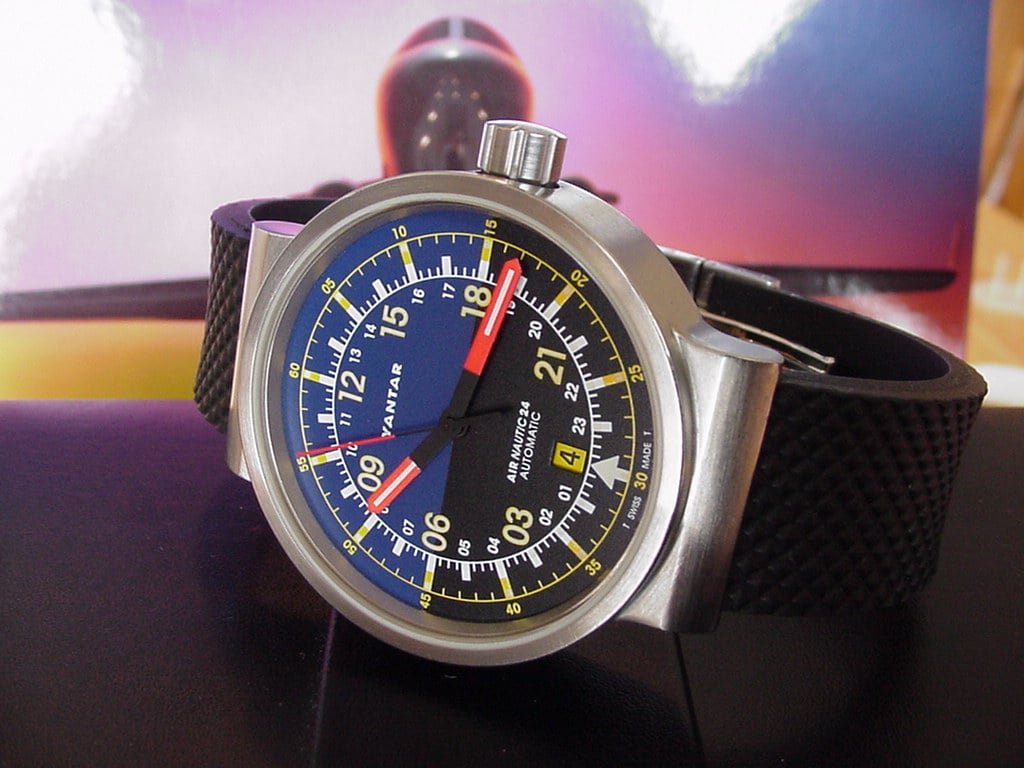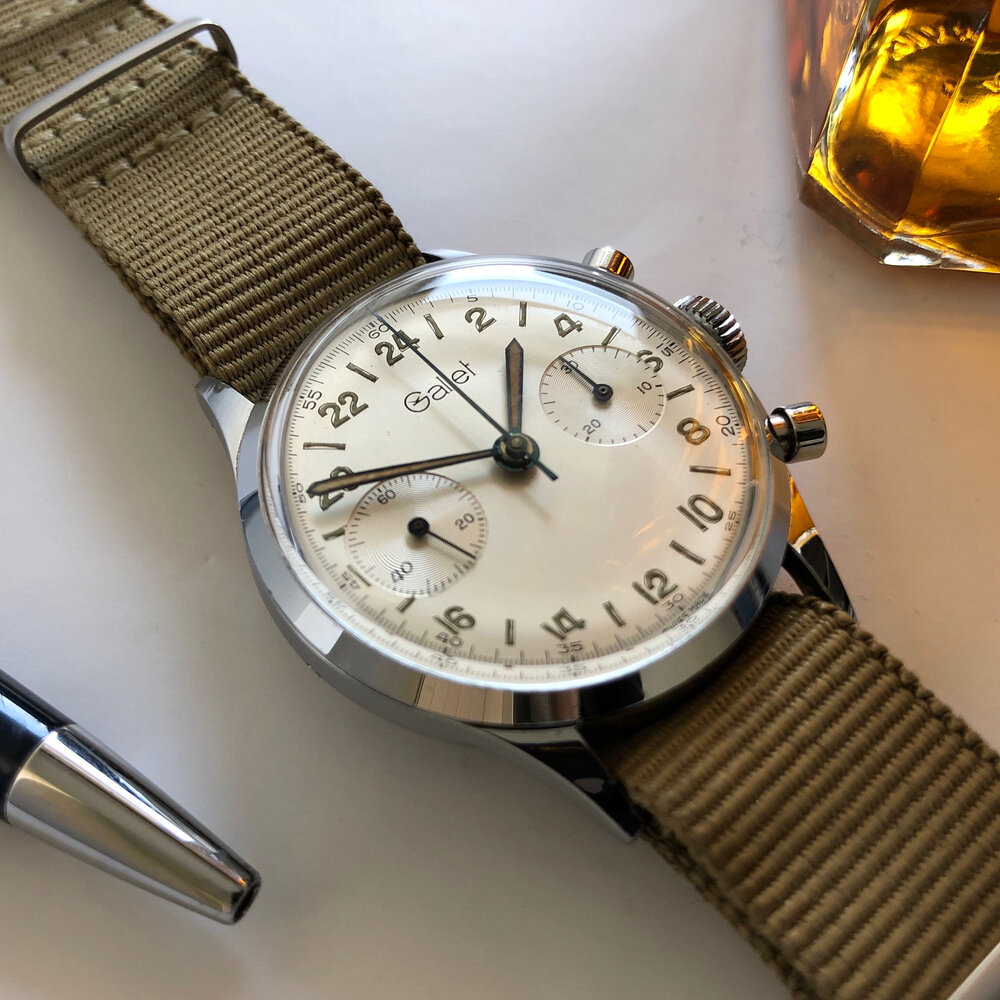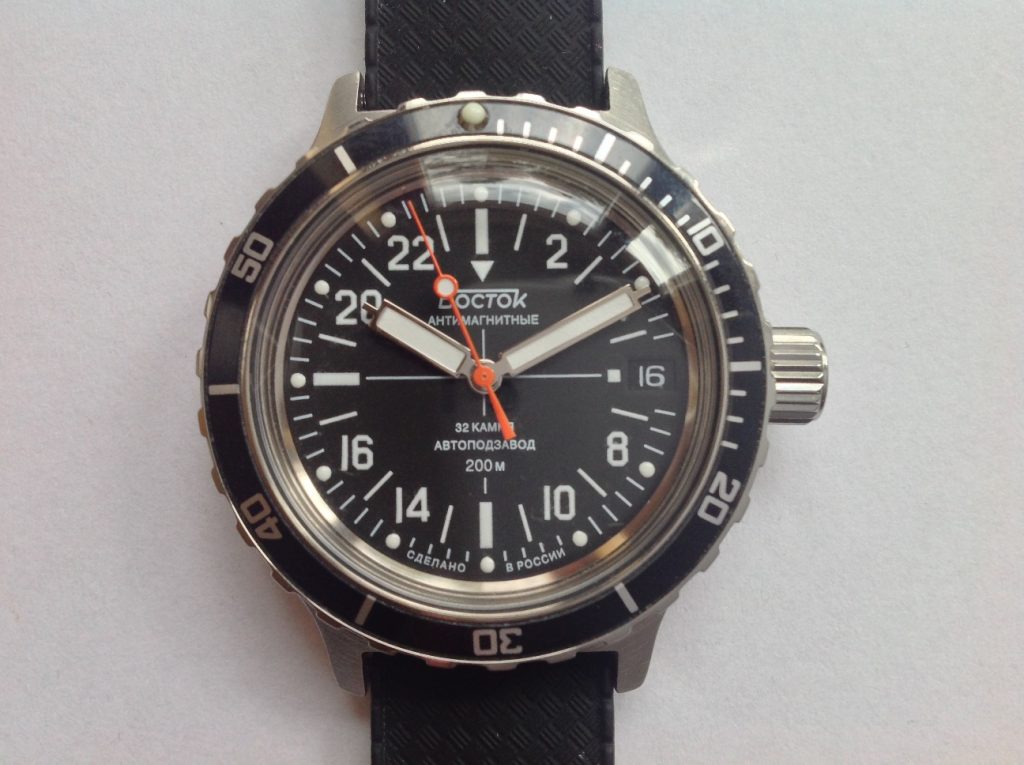The vast majority of analog watches feature twelve hours on their dials. Some may indicate in some way whether it is AM or PM, while with others, it is up to you based on context to recognize what time it is.
But did you know that there are also analog watch dials that feature 24 hours? Instead of revolving twice around the dial over the course of a day, the hour hand need only revolve once.
Table of Contents
Why a 24-Hour Watch?
The majority of people who use 24-hour analog watches are professionals, and the nature of their jobs and fields (i.e. military, scientific research) tells you something about their advantages.
Whether you are looking for a watch for professional or personal use, here are some of the benefits of going with a 24-hour analog dial over the traditional 12-hour analog dial:
- Instantly see exactly what time it is. If you are deeply involved in a complicated task, you don’t need to waste any extra time or thought when checking your watch.
- Using a 24-hour time system at work (as in the military)? If someone asks you the time, you won’t have to do math or rely on memory to give them the right answer in the afternoon or evening. You look at your watch, and it tells you the right number to say. So, you won’t find yourself going, “7:00 … what is that …” in the evening, and counting forward from 12. You will look at your watch, and it will simply say, “19.”
- You don’t need to rely on context clues. Maybe you are indoors and have been working a long, hard shift, and have no clue if it is night or day outside. Or maybe you are a researcher at one of the poles, and it is always bright or dark outside, providing you no context clues for AM or PM. Or perhaps you are a pilot or work some other job which requires regular travel. Your 24-hour watch will tell you the precise time with no room for guesswork.
- 24-hour watches are cool! They have a long history of use, and there are many exemplary specimens you can obtain for your collection.
Do 24-Hour Watches Have Any Drawbacks?
The main drawback of a 24-hour watch is that you have to get used to it. There is a learning curve, because since childhood onward, you have almost certainly been trained to read a 12-hour clock, and to do so almost effortlessly. You may scarcely pay attention to the digits, and simply look at how the hands are positioned to tell what time it is.
When you start using a 24-hour watch, you have to unlearn those hour hand positions and what they mean. You have to learn to visualize an entire day around 360 degrees, rather than simply half a day. Not only that, but you have to get used to looking at a more “crowded” watch face.
How easy or hard the transition will be will depend on you as a person. Some people find it relatively easy to switch to a 24-hour watch, or even intuitive. Others may take longer to get used to it, but may still find the benefits well worth the effort.
Who Uses 24-Hour Watches?
Here are some examples of who might benefit from a 24-hour watch:
- Pilots and other crew members on aircraft
- Anyone with a job requiring frequent transit
- Researchers or others in remote locations
- People who work indoors without windows
- Members of the military
- Anyone who prefers to express time in military hours
- Hobbyists who simply love 24-hour watches
It should be pretty easy to guess based on your occupation, location, or personal preferences whether a 24-hour timepiece would serve you well.
History of the 24-Hour Watch
24-hour timepieces are technically the oldest timepieces in the world.
Why? Because the earliest timepieces didn’t use mechanical parts—they simply used a wedge on top of a disc to show the position of the sun. I am referring to sundials; you might even have one in your backyard.
There are many types of sundials, but their dials represent the 24-hour day, because it takes a full day for a complete revolution to occur. Sometimes all 24 hours are marked; other times only the daylight hours are marked.
Before there were 24-watches, there were 24-hour clocks. These were commonplace during the Middle Ages.
With both sundials and clocks, sometimes the marks would be numbered I-XXIV, but other times, they would be numbered I-XII twice (essentially the same as an AM, PM system).
You may also find this photograph intriguing:

The photograph was submitted by the UK Parliament account on Flickr, and shows a glimpse of the inner workings of Big Ben. Even though Big Ben’s face only shows 12 marks, you can see that this internal dial shows 24. Pretty fascinating!
Common Configurations for 24-Hour Watch Faces
Most 24-hour watches and other 24-hour analog timepieces are configured in one of two layouts:
– Noon may be positioned at the top of the dial:

Or …
– Noon may be positioned at the bottom of the dial:

In every case, you will find midnight directly opposite noon.
So, if noon is at the top, midnight is at the bottom. If noon is at the bottom, midnight is at the top.
While the vast majority of 24-hour analog dials have one of these two layouts, you will find some that occasionally place noon on the far right or the far left, and midnight opposite it.
The marks may be numbered either 1-24 (or the Roman numeral equivalent), or 1-12 twice.
If you see the numbers 1-24, then you know automatically where midnight is and where noon is.
But if you see 1-12 twice, you will need to figure out which side is showing AM hours and which side is showing PM hours.
Watches with 24-hour marks may portray AM and PM in some way, for example, with one half of the watch in a light color to denote daytime, and the other in a dark color to denote night.
Selection of Interesting 24-Hour Watches
Now that you know a bit about the history of 24-hour watches and some of their possible configurations, let’s check out some of the brands which manufacture them and some examples of beautiful 24-hour timepieces (both vintage and modern).
Glycine Airman 24 Hour Automatic Watch (60s Model)

The Swiss watch brand Glycine was founded in 1914, and is renowned for its 24-hour analog Airman watches starting from 1953. These watches feature a black dial with highly readable numbers and a bold hour hand. Popular with military personnel of that era.
Gallet & Co. 24-Hour Multi-Chronograph

Another Swiss brand to turn to for 24-hour watches is Gallet. The company takes its name from its founder Humbertus Gallet, who crafted clocks as early as 1466.
One particularly iconic 24-hour watch manufactured by Gallet is the Gallet 24-hour Multi-Chronograph, also sometimes called the “MultiChron 24.”
The MultiChron 24 features a Valjoux 7730 movement and a dial with 24 on top and 12 at the bottom. While the first series had a black dial, the second series had a white dial. Features that instantly catch the eye include the “G” in the Gallet name which features a watch hands design, and the intriguing hands which are tan in the middle with black borders. PomeloWatches.com did an excellent review of this watch.
Vintage Raketa Watches
If you are interested in vintage Soviet watches, you doubtless are well-acquainted with Raketa, a brand of the Petrodvorets Watch Factory in St. Petersburg. The name “Raketa” translates to “Rocket,” and honors cosmonaut Yuri Gagarin.

Raketa became a major manufacturer of 24-hour watches for professional use. They made quite a few 24-hour timepieces powered by the reliable movement 2623.H. Let’s check out a couple of their cool designs.
Raketa 24-hours “Polar” or “Arctic”

This eye-catching watch is sometimes nicknamed as “Polar” or “Arctic”. The rotating (using the crown at 8 o’clock) inner bezel features a 4-hour shift in red.
Raketa 24-hours World Time

The 24-hours World Time’s rotating inner bezel shows different cities across the world and allows you to instantly check the time in a different time zone (some time zones changed since this watch was released though!). Note: Raketa also made a regular World Time watch with a 12-hours dial.
Vostok 24-hour Watches

Another Russian watch brand that has manufactured some stunning (and, importantly, affordable!) 24-hour timepieces is Vostok. In this case, we are talking about modern watches as I don’t remember seeing any 24-hour Vostok timepieces from the USSR era. Vostok uses a mechanical movement 2431 to power their 24-hour watches. The picture above is a special edition 420 SE released in 2016, which had a particularly good value proposition (it was sold for around $100). Now these are out of stock but sometimes can be found on the bay at a premium. Another option is the selection of Vostok 24-hour watches on Amazon, some of them look pretty good.
Oris Blue Eagles Limited Edition

Want something bolder? How about this massive Oris, celebrating the 40th anniversary of the Blue Eagles Helicopter Display Team. Being a modern Swiss watch, it unfortunately costs like 15 vintage Raketa’s.
Conclusion: A 24-Hour Watch is a Distinctive, Unambiguous Way to Read the Time
Whether you require a watch that tells military time or you simply love the unique look and unambiguous function of a 24-hour analog watch, it is well worth adding one to your collection. With brands like Raketa, Glycine, Gallet and others, you will find no shortage of amazing vintage and modern timepieces to wear or display from around the globe.
Vintage Watch Inc
Dennis is the founder and editor of Vintage Watch Inc. Passionate about Soviet and Japanese vintage timepieces and a finance professional by day, he proudly wears a Seiko Pogue with his suit.




Hi Vintage Watch club, Thank you for this lovely article about 24 hour watches. I just “dug up” my Raketa World Time and Dolphin 24 hour watches and I was looking for some info about the Raketa World Time watch. I have exactly the same as shown on this page with the exception that the names of the cities are in English on my watch. I’ve been a fan of 24 hour watches for quite a while now, and I also “embraced” 24 hour quartz watches, many of them with the same Swiss 24 hour Ronda movement. A watch like… Read more »
Frank, thanks a lot for taking the time to write this comment. Your assumption makes a lot of sense!
Recently, I have begun to deal with the history of watches. A really exciting topic! I was surprised to learn that one-hand watches were common a long time ago. I did not know that the additional hands were only introduced over time. In my search for a special wristwatch, I was particularly attracted to the Uno 24 by Botta Design. I find the reading of the time intuitive. It’s great that there is now such a wide variety of different watches! Why the change from 24 hour dials to 12 hour dials was introduced, I do not know. But I… Read more »